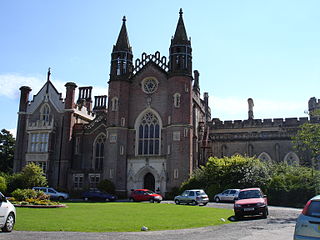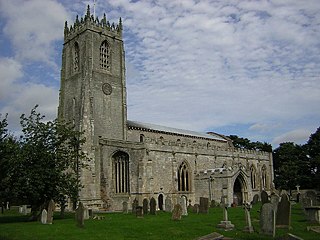
Blyth is a village and civil parish in the Bassetlaw district of the county of Nottinghamshire, in the East Midlands, north west of East Retford, on the River Ryton. The population of the civil parish as of the 2011 census is 1,233. It sits at a junction with the A1, and the end of the motorway section from Doncaster.

Evesham Abbey was founded by Saint Egwin at Evesham in Worcestershire, England between 700 and 710 AD following an alleged vision of the Virgin Mary by a swineherd by the name of Eof.

Penwortham is a town in South Ribble, Lancashire, England, on the south bank of the River Ribble facing the city of Preston. The town is at the most westerly crossing point of the river, with major road and rail links crossing it here. The population of the town at the 2011 census was 23,047.

Arncott or Arncot is a village and civil parish about 3+1⁄2 miles (5.6 km) southeast of Bicester in Oxfordshire. The 2011 Census recorded the parish's population as 1,738.

Hutton Grammar School is a voluntary aided Church of England day school for boys, with a co-educational Sixth Form. It is located 3 miles (4.8 km) south west of Preston, Lancashire, in Hutton, England. It provides education for boys from the age of 11 to 16, and in the Sixth Form for both boys and girls. The school no longer offers boarding. The school is ranked 5th in the league tables in the North-West and 2nd place for AS-A2 results. It was also the Lancashire Rugby School of the Year, for two years running, for 2007 and 2008. Hutton has also achieved Specialist Schools Status accreditation in Mathematics and Computing.

The Priory of St. Mary the Virgin and St. Martin of the New Work, or Newark, commonly called Dover Priory, was a priory at Dover in southeast England. It was variously independent in rule, then occupied by canons regular of the Augustinian rule, then finally monks of the Benedictine rule as a cell of Christchurch Monastery, Canterbury.

St John's Abbey, also called Colchester Abbey, was a Benedictine monastic institution in Colchester, Essex, founded in 1095. It was dissolved in 1539. Most of the abbey buildings were subsequently demolished to construct a large private house on the site, which was itself destroyed in fighting during the 1648 siege of Colchester. The only substantial remnant is the elaborate gatehouse, while the foundations of the abbey church were only rediscovered in 2010.

Börringekloster Castle, formerly Börringe Priory is a castle built in 1763 on the ruins of a medieval Benedictine priory at Svedala in Scania, Sweden.

Conishead Priory is a large Gothic Revival building on the Furness peninsula near Ulverston in Cumbria. The priory's name translates literally as "King's Hill Priory". Since 1976, the building has been occupied by a Buddhist community.

Hutton is a village and civil parish in Lancashire, England. It is located 3 miles (4.8 km) south west of Preston, in the South Ribble borough and parliamentary constituency. The population of the civil parish at the 2011 census was 2,277.

Forest Hill is a village in Forest Hill with Shotover civil parish in Oxfordshire, about 4.5 miles (7 km) east of Oxford. The village which is about 330 feet (100 m) above sea level is on the northeastern brow of a ridge of hills. The highest point of the ridge is Red Hill, which rises to 440 feet (130 m) just south of the village. The 2011 Census recorded Forest Hill with Shotover's population as 856.

St Chad's Church is an Anglican church in Poulton-le-Fylde, Lancashire, England. It is an active parish church in the Diocese of Blackburn and the archdeaconry of Lancaster. It is recorded in the National Heritage List for England as a designated Grade II* listed building. A church on the site was built no later than the 11th century and may have existed prior to the Norman conquest of England. The tower dates from the 17th century, and much of the remainder of the building from a major renovation in the 18th century, although some of the fabric of the original structure remains. Further renovation and additions took place in the 19th, 20th and 21st centuries.

Gresley Priory was a monastery of Augustinian Canons regular in Church Gresley, Derbyshire, England, founded in the 12th century.

Lytham Priory was an English Benedictine priory in Lytham, Lancashire. It was founded between 1189 and 1194 by Richard Fitz Roger as a cell of Durham Priory. It was dedicated to Saint Cuthbert and lasted until Henry VIII dissolved the monasteries in 1530s. In the 18th century, a manor house, Lytham Hall, was built on the site of the priory.

Belvoir Priory was a Benedictine priory near to Belvoir Castle. Although once described as within Lincolnshire, it is currently located in Leicestershire, near the present Belvoir Lodge.

Blyth Priory was a priory in Nottinghamshire, England, dedicated to St Mary the Virgin.

St Mary's Priory and Cathedral was a religious institution in Coventry, England, founded in the 12th century by transformation of the former monastery of St Mary, and destroyed during the Dissolution of the Monasteries in the early 16th century. It was located on a site north of Holy Trinity and the former St Michael's parish churches in the centre of the city, on a site bordered by Priory Row to the south, Trinity Street to the west, and the River Sherbourne to the north. Excavated remains from the west end of the cathedral are open to the public.

St. Mary and St. Martin's Church, Blyth, is a Grade I listed parish church in Blyth, Nottinghamshire, England.
Penwortham Priory Academy is a coeducational secondary school located in Penwortham in the English county of Lancashire.



















